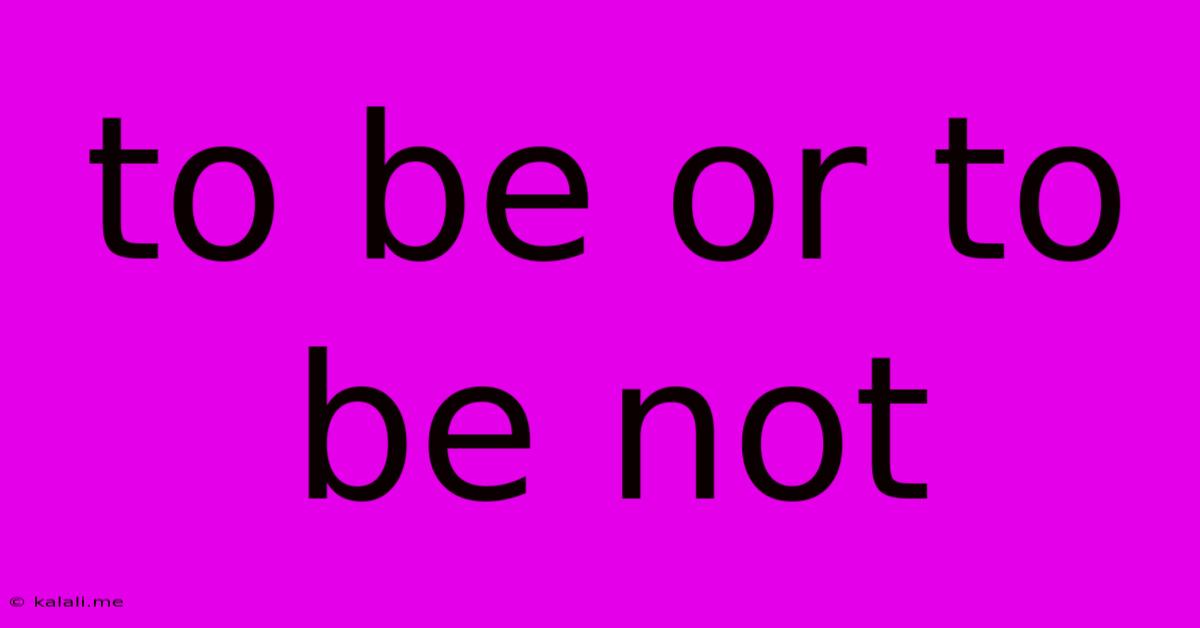To Be Or To Be Not
Kalali
Jun 09, 2025 · 3 min read

Table of Contents
To Be or Not to Be: A Modern Exploration of Hamlet's Timeless Question
Hamlet's famous soliloquy, "To be or not to be," transcends its Elizabethan origins, resonating with audiences across centuries. This seemingly simple question of life versus death delves into much deeper philosophical territory, exploring themes of suffering, action, and the unknown. This article will unpack the enduring relevance of Hamlet's contemplation and explore its application to modern life.
What Makes This Soliloquy Enduring?
The enduring power of "To be or not to be" lies in its universality. While rooted in Hamlet's specific circumstances – revenge, betrayal, and a world steeped in political intrigue – the underlying anxieties are timeless. We all grapple with existential questions: What is the purpose of life? Is suffering unavoidable? Is death a preferable alternative to pain? These are not merely academic debates; they are deeply personal and intensely human.
Deconstructing the Soliloquy: Beyond Suicide
It's crucial to understand that Hamlet isn't simply contemplating suicide. While the line "To die, to sleep" suggests a peaceful end, the soliloquy is more complex. He weighs the unbearable weight of life's burdens ("the slings and arrows of outrageous fortune") against the terrifying uncertainty of what lies beyond death ("the undiscovered country"). This uncertainty is the core of his struggle. The fear of the unknown is often a more potent deterrent than the pain of the present.
Modern Interpretations and Applications:
The "To be or not to be" question manifests in modern life in various ways:
- Career Choices: Should I pursue a stable, predictable career path, or risk everything for a potentially more fulfilling but uncertain one? This echoes Hamlet's dilemma of action versus inaction.
- Relationship Decisions: Should I stay in a difficult or unfulfilling relationship, or face the pain and uncertainty of being alone? The fear of the unknown, again, plays a significant role.
- Facing Challenges: Should I confront a difficult problem head-on, risking failure, or avoid it, potentially prolonging suffering? This speaks to the weighing of present pain against the potential for future relief or progress.
Finding Meaning in the Present:
Hamlet's contemplation, while profound, doesn't offer easy answers. There's no simple resolution to the "To be or not to be" question. However, the enduring value lies in the process itself – the act of questioning, reflecting, and grappling with life's complexities. The true takeaway may not be a definitive answer, but rather a renewed appreciation for the present moment and the courage to navigate the uncertainties of life.
Beyond the Text: The Legacy of the Soliloquy
The soliloquy has had an undeniable impact on literature, theater, and popular culture. Its themes have been explored and reinterpreted countless times, solidifying its position as a cornerstone of Western literature. Its influence extends far beyond the realm of academics, shaping our understanding of human nature and the enduring struggle to find meaning in a complex world. Understanding Hamlet's dilemma allows us to better understand ourselves and the choices we face each day.
Keywords: To be or not to be, Hamlet, Shakespeare, soliloquy, existentialism, life, death, suffering, uncertainty, meaning of life, modern interpretation, philosophical questions, decision making, courage, legacy.
Latest Posts
Latest Posts
-
How Many Shots In A Half Gallon
Jul 01, 2025
-
Someone Once Told Me The World Was Macaroni
Jul 01, 2025
-
How Long Does It Take To Walk Five Miles
Jul 01, 2025
-
How Many Ounces Is A Pint Of Blueberries
Jul 01, 2025
-
How Many Dimes Are In 5 Dollars
Jul 01, 2025
Related Post
Thank you for visiting our website which covers about To Be Or To Be Not . We hope the information provided has been useful to you. Feel free to contact us if you have any questions or need further assistance. See you next time and don't miss to bookmark.